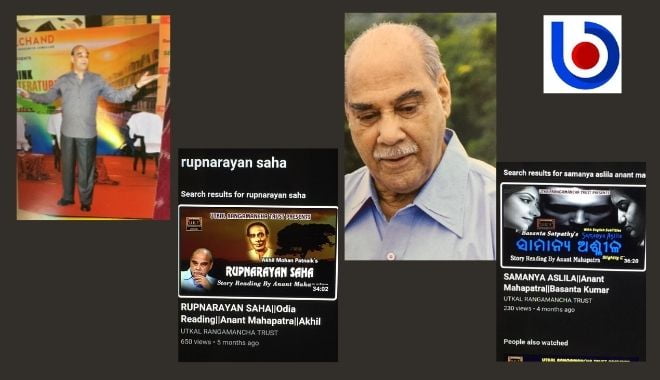Virtual Reading: A New Initiative By Thespian Ananta Mahapatra

Anant Mahapatra needs no introduction, of course. He is one of the most renowned thespians and theatre personalities of Odisha now living. Mahapatra founded the professional theatre group Srujani in the 1960s. In the recent years he has set up the Utkal Rangamanch Trust to revive the professional theatre movement in contemporary Odisha. He has directed over a hundred plays, including, most recently, Shakespeare’s King Lear. Though over eighty, his years sit lightly on him as he is constantly ideating and re-inventing himself. Forced indoors by the raging pandemic, Mahapatra has been doing this from the comfort of the living room of his heritage-style home ‘Purabi’.
Reading for the Spoken Word
One of these innovations is his reading aloud of short stories by prominent Odia writers with a view to giving them a new lease on life. This invites comparison with Dickens who is famously known to have turned in his late years to public readings from his novels. Dickens’s public readings were a rage in England. Mahapatra has, likewise, offered his readings, but in the virtual mode, considering these strange and unsettling Covid times. The book stand and the stick as Dickensian-stage props have been replaced by other prompts and props specific to the digital age. The voice has, however, stayed on as a bridge between the past and the present, pushing literature back towards its originary moment as ‘winged word’, as inspired utterance.
Mahapatra’s brand of readings, beamed on the screens of our mobile phones, I-Pads, tabs and laptops—and even television if you have the time and inclination to attach yourself to a fixed spot in a mobile world—kicked off on 8 November 2020 with the reading of a story called “Rupnarayan Saha” by the acclaimed short story writer Akhil Mohan Patnaik, set in Benares in 1955. From then on have come at a steady pace “Matsyagandha” (A Woman Smelling Like Fish) and “Ranibai” by the same writer, and, “Tera Minit” (Thirteen Minutes) and “Samanya Aslila” (Slightly Obscene) by Basanta Kumar Satpathy. His repertoire is impressive and is steadily growing, but it is the mechanics of his reading that concerns me here.
Nuts and Bolts of Reading
The standard presentation format of a Mahapatra reading consists, like the news story, of a lead and a body. The lead is the brief introduction of the author of the piece, given by either Mahapatra himself, as in the case of Patnaik, or by someone who knows the author well—Sumanyu Satpathy in the case of Basanta Kumar Satpathy. The body is the dramatic reading—with wonderful tonal variation—in Anant’s rich baritone voice to the syncopated accompaniment of sounds that bring the world of the story alive. This can be the tin tin of a cycle rickshaw, the clatter of vehicular traffic, jingling of anklet bells of the mujra dancer, the train steaming out of or into the platform, the boat slicing through water, the murmur of the river, or bird calls. This is the basic furniture of the reading. But Mahapatra has also brought a rich audio-visual experience to the listener-cum-watcher. He has added English subtitles—translated by Ashok Mohanty—to each of these videos, thus making these readings available for a wider audience.
The voice, however, dominates the proceedings. As Mahapatra enunciates every word, letting the emphasis fall on certain words or names that are to the story what refrains are to music—like ‘Dalmandi’, the exotic flesh pot of Benares in “Rupnarayan Saha”, or ‘Phoolkumari’, the beautiful seductress in “Samanya Ashila”—the story is vividly enacted for the listener.
Resurrecting the Oral
It goes without saying that Mahapatra couldn’t have pulled off the feat without support from his creative team of camera person and sound recorder. More importantly, he couldn’t have done it without some help from the stories themselves, which are beautifully told. He gravitates towards those stories which are written to showcase the resources of the spoken word, both of the hieratic variety, as with Patnaik, and of the street variety, as with Satpathy. It would appear that Patnaik and Satpathy are his kind of writers in that they belong to the oral tradition.
If this is the case, it is unsurprising that Mahapatra would eventually want to cut his reading teeth on Fakir Mohan Senapati’s Chha Mana Atha Guntha, at once the root and the apex of Odia story telling.
He has completed his reading of the entire novel and recorded it, reportedly a marathon session of five plus hours in which the reading wizard has met and taken the measure of the writing maestro.
I, for one, cannot wait to take a listen.
(Anant Mahapatra’s readings and plays have been uploaded on the YouTube channel of the Utkal Rangamanch Trust.)

Comments are closed.